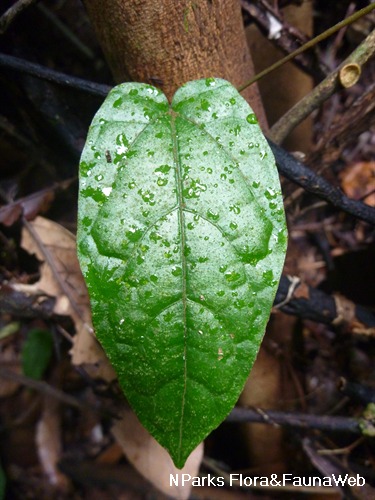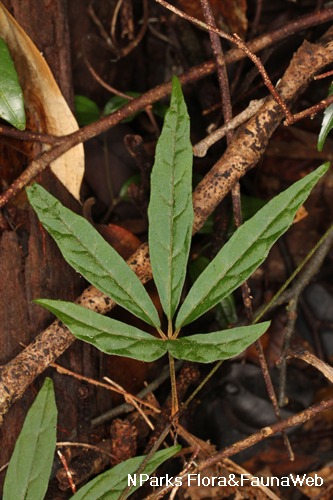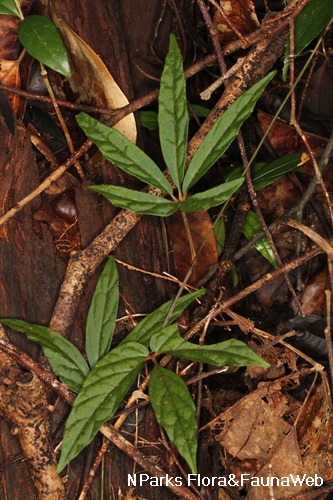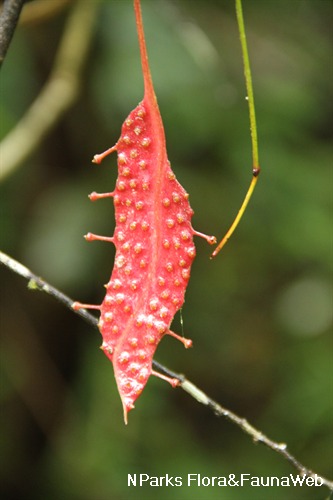
Back
Pterisanthes cissoides Blume
| Family Name: | Vitaceae |
| Synonyms: | Pterisanthes dalhousiae Ridl. var. major, Pterisanthes trifoliata Merr., Vitis pterisantha Miq. |
| Common Name: | Akar Gamat |
Name
Classifications and Characteristics
| Plant Division | Angiosperms (Flowering Seed Plants) (Dicotyledon) |
|---|---|
| Plant Growth Form | Climber |
| Lifespan (in Singapore) | Perennial |
| Mode of Nutrition | Autotrophic |
Biogeography
| Native Distribution | Sumatra, Peninsular Malaysia, Singapore, Java, and Borneo |
|---|---|
| Native Habitat | Terrestrial (Primary Rainforest, Secondary Rainforest, Freshwater Swamp Forest) |
| Preferred Climate Zone | Tropical |
| Local Conservation Status | Native to Singapore (Critically Endangered (CR)) |
Description and Ethnobotany
| Growth Form | It is an herbaceous climber. |
|---|---|
| Foliage | Its spirally arranged, stalked leaves have 3–5 papery leaflets. The terminal leaflet is long egg-shaped to oval and 10–18 by 4.1–6.9 cm. The lateral leaflet is asymmetric oblong and 9.1–16 by 4–6.7 cm. |
| Flowers | Its stalked flowering shoot is brownish-green and 15–39 cm long. It mostly bears stalkless flowers. |
| Fruit | Its fruits are egg-shaped berries and contain 1–2 seeds each, ripening purplish-pink. The seed is up to 6 by 5 mm. |
| Habitat | It grows on the fringe of lowland dipterocarp forests. It occurs locally in Nee Soon Swamp Forest. |
| Associated Fauna | Its flowers are pollinated by insects, and its fruits and seeds may be eaten and dispersed by birds. |
| Cultivation | It can be propagated by seed. |
| Etymology | Greek pteron, wing; Greek anthe, flower, probably referring to the flat blade-like inflorescence; Latin cissoides, like Cissus genus, the reference to its appearance that resembles plants from the genus Cissus. |
| Ethnobotanical Uses | Medicinal: The roots are rubbed on swellings on legs. |
Landscaping Features
| Landscaping | It may be suitable for parks, at partially shaded areas. |
|---|---|
| Desirable Plant Features | Ornamental Flowers, Ornamental Foliage |
| Landscape Uses | Parks & Gardens, Small Gardens |
Fauna, Pollination and Dispersal
| Pollination Method(s) | Biotic (Fauna) |
|---|---|
| Seed or Spore Dispersal | Biotic (Fauna) |
Plant Care and Propagation
| Light Preference | Semi-Shade |
|---|---|
| Water Preference | Moderate Water |
| Plant Growth Rate | Moderate |
| Rootzone Tolerance | Moist Soils, Well-Drained Soils, Fertile Loamy Soils |
| Maintenance Requirements | Moderate |
| Propagation Method | Seed |
Foliar
| Foliage Retention | Evergreen |
|---|---|
| Mature Foliage Colour(s) | Green |
| Mature Foliage Texture(s) | Papery |
| Foliar Type | Simple / Unifoliate, Compound (Trifoliate) |
| Foliar Arrangement Along Stem | Alternate |
| Foliar Attachment to Stem | Petiolate |
| Foliar Shape(s) | Non-Palm Foliage (Ovate) |
| Foliar Venation | Pinnate / Net |
Floral (Angiosperm)
| Flower & Plant Sexuality | Bisexual Flowers |
| Flower Grouping | Cluster / Inflorescence |
|---|---|
| Flower Location | Axillary |
| Flower Symmetry | Radial |
Fruit, Seed and Spore
| Mature Fruit Colour(s) | Pink, Purple |
|---|---|
| Fruit Classification | Simple Fruit |
| Fruit Type | Fleshy Fruit , Non-Accessory Fruit |
Image Repository
Others
| Master ID | 31553 |
|---|---|
| Species ID | 5952 |
| Flora Disclaimer | The information in this website has been compiled from reliable sources, such as reference works on medicinal plants. It is not a substitute for medical advice or treatment and NParks does not purport to provide any medical advice. Readers should always consult his/her physician before using or consuming a plant for medicinal purposes. |







